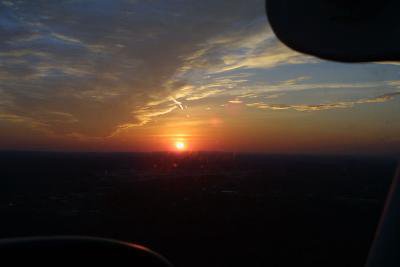Playing in the clouds
As a kid, I often wondered what it'd be like to touch a cloud. Like probably many others, I thought of them as monuments fashioned from cottonwool or cotton candy and fantasized about playing and sleeping in their inviting canyons closer to where airplanes lived.
That little kid was reawakened today during a thrilling flight from Manassas to Raleigh, most of it (1.6 hours) in IMC. The trip also marked my first (benign) ice encounter.
My school's program includes a couple of weeks of cross-country flights -- pilot speak for trips to other airports -- during which two students fly together as a crew. Just like at an airline, a dispatcher assigns us a destination. Unlike at the airlines, however, dispatch doesn't flight plan for us. Once we've surveyed our route and checked the weather, we file IFR and advise dispatch, who then release us if they deem the conditions acceptable.
The students act as a crew and practice CRM, or cockpit resource management. One will fly one leg while the "pilot monitoring" reads checklists, tunes radios, talks to ATC and provides a second pair of eyes to ensure a safe flight.
Today was my first of many such trips to come in the next two or so weeks and I was lucky to be paired with a very competent, responsible, professional and safe pilot who just happened to share my interests for food, beer and wine.
After planning the flight, we agreed I'd fly the first leg to Raleigh.
We set off on this maiden voyage mid-afternoon. I knew we'd spend some time in the clouds and we had resolved to keep a close eye on icing, for which the weather briefer told me there was potential along our route. We flew the Arsenal 1 Departure to the Gordonsville transition and found ourselves in the clouds within minutes of take-off.
(As a sidenote, our flight plan basically consisted of flying a departure procedure the transition of which was also the first point of our destination's STAR! Kinda cool I thought.)
As we neared that first cloud I asked Peter whether he had much experience in actual.
"About one hour," he said.
I had a meager 4.4 hours of actual, the last 1.2 of which I flew in July.
We popped into the white mass and my eyes turned to the instruments, instinctively scanning the panel to gather information to keep the plane upright, at our assigned altitude and on track. No biggie, things went well and I quickly relaxed. By the way, the twin we fly has no autopilot so being lazy was not an option.
Closer to Manassas, the clouds were stacked close together so we popped in and out of puffy cumulus clouds that rose above us like small monuments. At times, we broke out for a few seconds and found ourselves flying in valleys of clouds, only to quickly re-enter the white mass. Occasionally, as the layer would thin out a little bit, we skimmed the tops and caught a glimpse of blue sky in the mist above before promptly returning into the vast ocean of white.
As we made our way south, the broken clouds gave way to solid IMC. I told Peter that we should remain vigilent for icing and we discussed our options if ice were to stick to our aircraft and complicate matters by robbing us of performance. The outside air temperature was in the vicinity of -10C so we'd have to be on our toes.
Nearer to Raleigh, after a relaxed and very satisfying flight in IMC, the inside of the clouds turned a little darker and I suspected more moisture was hanging in the air. I shared my hunch with Peter and we again checked for ice.
"I see some accumulation over here, how is it on your side," he asked.
I glanced at the wing's leading edge and could see light rime ice gathering.
Hmm. There wasn't much so I decided to wait a few seconds and see how much more would accumulate. Still not a lot, but I'm inexperienced in IMC and new to this whole icing thing, so let's take no chance. We advised ATC and asked if we could get a lower altitude. A minute later we began a descent to 3,000 ft and broke out into drier air.
The small amount of ice melted reasonably rapidly and whatever had accumulated on the right engine's propeller was thrown against the windshield.
Approach vectored us to the ILS 5L at RDU and minutes later we were enjoying surpisingly good coffee from a fancy and, I'm told, very expensive machine boasting the logo of an ubiquitous chain of coffee shops.
Dispatch told us we were to fly to Atlanta from Raleigh, but soon called back and instead instructed us to return to Manassas since bad weather is forecast for the next two days.
Peter flew smoothly all the way home in marginal VFR conditions and shot a nice GPS approach into Manassas.
The flight was nothing short of awesome. The first post-checkride IMC flight is a true test for an instrument pilot, especially one who had none or little experience in the clouds during training and had to instead slap on those annoying foggles or other view-limiting devices go simulate them.
I feel that I did well and had a lot of fun. Thankfully, there was only little turbulence in those clouds and icing was very limited. But to a green instrument pilot, who wondered whether he'd be even able to keep the plane's proper side up in a cloud, it was a big step forward.
With any luck, temperatures will be warmer than forecast tomorrow and we'll spend some more time playing among the clouds.



1 Comments:
Yup, clouds are neat. There's nothing quit like having that sense of motion while you're significantly AGL.
But, you need to post some could pictures!
Post a Comment
<< Home